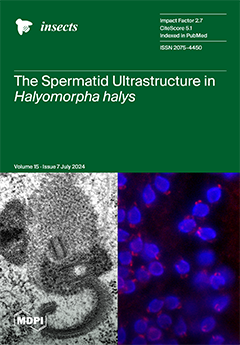Flonicamid is a novel systemic insecticide widely used against aphids. However, the intergenerational sublethal effects of flonicamid on cotton aphid,
Aphis gossypii, have not been fully studied. This study aimed to evaluate the sublethal effects of flonicamid on the biological parameters of adult
[...] Read more.
Flonicamid is a novel systemic insecticide widely used against aphids. However, the intergenerational sublethal effects of flonicamid on cotton aphid,
Aphis gossypii, have not been fully studied. This study aimed to evaluate the sublethal effects of flonicamid on the biological parameters of adult
A. gossypii (F
0) and its subsequent intergenerational effects on the offspring (F
1 generation) through age-stage, two-sex life table analysis. The results of the bioassays indicate that flonicamid exhibits significant toxicity toward adult
A. gossypii, as evidenced by an LC
50 value of 0.372 mg L
−1 after a 48-h exposure period. The longevity, fecundity, and reproductive days of adult cotton aphids (F
0) were significantly decreased when treated with the sublethal concentrations of flonicamid. The pre-adult stage exhibited an increase, whereas the adult longevity, total longevity, and fecundity experienced a notable decrease in F
1 aphids after the exposure of F
0 aphids to sublethal concentrations of flonicamid. Furthermore, the key demographic parameters, including
r,
λ,
R0, and RP
d, showed a significant decrease, while the total pre-reproductive period (TPRP) experienced a significant increase in the F
1 generation. Collectively, our findings indicate that sublethal concentrations of flonicamid impact the demographic parameters of
A. gossypii, resulting in suppression of population growth. This study presents comprehensive information on the overall impact of flonicamid on
A. gossypii, which could potentially aid in managing this major pest.
Full article






